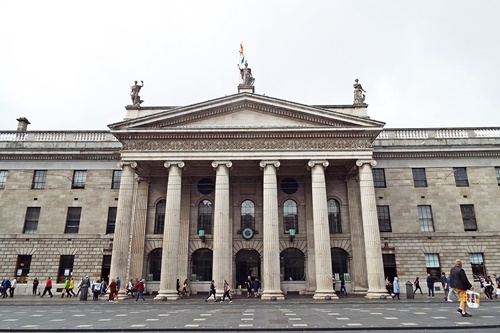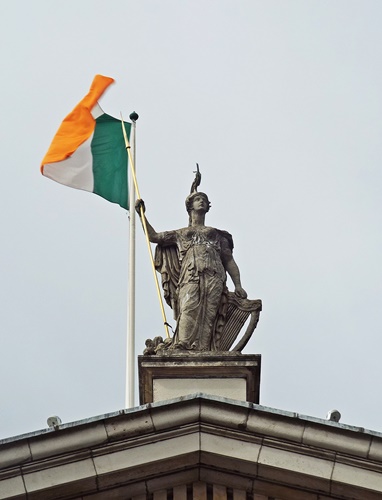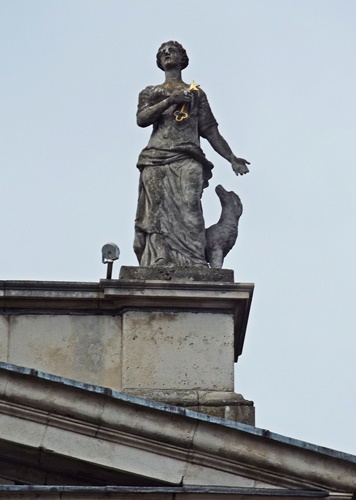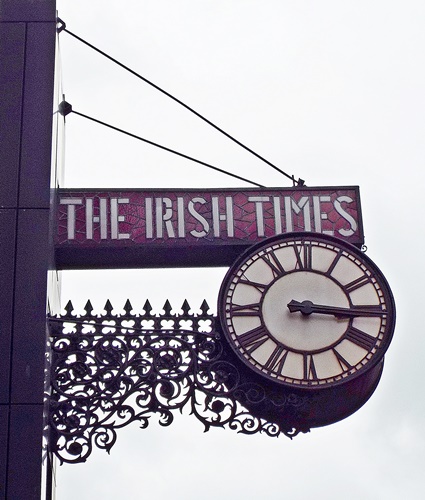A day in which I almost lost my phone again, went looking for bullet holes and experienced being ‘underwater’ without leaving dry land…
My day started with a lovely breakfast of scrambled eggs on toast done by Nellie then I set out to get the 9am coach to Dublin city. As per usual it was late and when I got on I found the driver was the same guy as the previous day – and just like the previous day he was going hell for leather then slapping the brakes on when he had to slow down or stop. This time though, to avoid my phone slipping out of my pocket I’d put it in my small bag along with my camera, notebook and pen, and the bag was on the seat beside me. It didn’t make a scrap of difference though – at one point the coach pulled up so sharply that my bag fell off the seat and the phone came out, skidding along the floor underneath the seats in front. Not being able to see how far it had gone I waited until the coach stopped at Portlaoise and while the driver was dealing with the queue of passengers I went in search of it, finding it by the feet of a lady sitting three seats in front of me. The rest of the journey to Dublin fortunately passed without further incident and I got off the coach near the Custom House on the north side of the river.
After buying the book ‘111 Places in the Lake District That You Shouldn’t Miss’ for my holiday in June, and finding it very interesting and informative, I’d since got the equivalent one for Dublin and using that book I’d made a list of all the things in the city centre which would be relatively easy to get to on foot, although not all in one day. Plus I had a few ideas of my own, so join me on my Monday walk this week as I roam round Dublin searching out various serious, quirky, and interesting features of the city.
My walk started at the outer perimeter of Beresford Place, the attractive gardens which surround the north, east and west sides of the Custom House. In the centre of the north side was a rectangular pool and a fountain, with a larger-than-life-size bronze statue of Eire (Ireland) supporting a dying soldier. Designed and erected in 1956 the statue commemorates those IRA members who died in an attack on the Custom House in 1921 during the War of Independence.

On the west side of Beresford Place, and standing in the shadow of an overhead rail line, was the statue of James Connolly, a Scottish-born Irish Republican and Socialist leader. He was centrally involved in the Dublin lock-out industrial dispute in 1913 and in 1916 was one of the leaders of the Easter Rising, aimed at ending British rule in Ireland and establishing an independent Irish Republic. Because of his leadership role in the Easter Rising he was executed by firing squad in May that same year.

Across the river, and facing the Custom House, was Georges Quay Plaza. A 13-storey complex of modern buildings completed in 2002, it houses the headquarters of Ulster Bank and is sometimes jokingly referred to as Canary Dwarf in reference to London’s Canary Wharf. Although it wasn’t actually on my list of things to find I took a photo just because I liked the pyramid-shaped roof tops at different heights.

Next was the Daniel O’Connell statue at the end of O’Connell Street. Although I’ve photographed it on previous occasions I didn’t know about the bullet holes until I read about them in the ‘111 Places’ book. Erected in 1882 in honour of ‘The Liberator’ the statue was very much in the line of fire during the 1916 Easter Rising and the larger-than-life bronze version of O’Connell was hit repeatedly. Also injured were three of the four angels who guard the monument’s base; the figure of ‘Courage’ was shot through her right breast and ‘Eloquence’ was hit in the elbow. A total of 30 bullet holes have been found throughout the monument, 10 of them on O’Connell himself – rather an unfortunate fate for the statue of a great parliamentarian who detested violence.


Halfway along O’Connell Street was the GPO (General Post Office) one of Ireland’s most famous buildings and the last of the great Georgian buildings to be erected in Dublin. The foundation stone was laid in August 1814 and the building was completed in about three years; the main part was built out of mountain granite while the front portico was of Portland stone. During the Easter Rising of 1916 the GPO was used as the headquarters of the Rising’s leaders but in the course of the rebellion the front portico was destroyed by fire and wasn’t rebuilt until 1929 by the Irish Free State government. In spite of its fame as a place of Irish freedom ground rent for the GPO continued to be paid to English and American landlords right up to the 1980s.




Just three streets behind O’Connell Street was Moore Street, Dublin’s oldest food market famous for its open-air fruit and vegetable stalls It wasn’t in the book but I wanted to take a look as it had featured in Mrs Brown’s Boys D’Movie – which, incidentally, isn’t as funny as the tv programmes. Back in 1916, at the end of the Easter Rising, five of the seven signatories of the Irish Proclamation of Independence, including James Connolly, surrendered to British forces from a terrace of houses on Moore Street; fast forward to 1998 and Dublin City Council wanted to demolish the terrace to redevelop the area but this was opposed by local groups who declared Moore Street and its surrounding area to be an important part of Irish history.
After many years of legal wrangling and campaigns to prevent redevelopment demolition work was scheduled to start in early 2016; legal action against it was started by campaigners and the houses were occupied and held for five days by protesters. The Save Moore Street 2016 campaign group was then formed and the site was blockaded to prevent building workers gaining access; the blockade was maintained for almost six weeks and was only lifted after a legal judgement finally found in the group’s favour. On March 18th 2016 Justice Max Barrett declared that the whole terrace, street and surrounding lanes constituted a national historic 1916 Battleground. The plot of the Mrs Brown’s Boys film follows a very similar theme, possibly based on these modern day real-life events but with many adaptations, but while the film is mostly fictitious Moore Street and its market certainly aren’t.

Back to the riverside and the next thing I wanted to see was the Dublin Port Diving Bell situated across the Liffey and beyond the Samuel Beckett bridge. Created by an Irish engineer with the unlikely name of Bindon Blood Stoney it was used in the construction of the city’s deep-water quays. Once lowered onto the seabed workers would climb down into the bell via the funnel – there was just enough room for six men to work – and they would flatten the seabed in preparation for huge concrete blocks to be laid. The bell was in service from 1871 to 1958 and in spite of the many risks involved the work on the quays never cost a life or even a serious injury.
After its working life was over the bell lay idle for many years and was in danger of being scrapped but in the 1980s it was hoisted onto one of the quays it had helped to build and left there, standing as a tribute to the many workers who had turned the former tidal harbour into a deep-water port. In spite of its heroic story it had no plaque or information to tell people what it was but in 2015 it was raised onto a specially constructed platform and transformed into a miniature museum which can be entered from two sides. Information panels around the walls give details of the bell and how it was used in the construction of the quays; the space inside is small and the sound of constantly running water underneath a steel mesh floor gives an idea of how the workers must have felt at the time.

Heading back west along the riverside I came to something which had intrigued me when I passed that way last December. An old red brick building was being demolished to make way for the completion of a huge partially constructed modern building but it seemed like the workers were taking care not to demolish the front wall. This has proved to be true, the front façade of the old building has been saved and given a clean up and the new modern building stands behind it, although the two aren’t connected. There’s a huge amount of construction work being carried out across the city and I’ve noticed before that many old buildings are being saved while new buildings are erected round them; the mixture of old and modern seems odd but in Dublin it works.
A bit further along the quayside, and sandwiched between two other modern buildings, was the Immaculate Heart of Mary church, founded in 1908 and belonging to the Parish of City Quay. It wasn’t even on my list or indeed in the book but it was open, so never one to resist a church interior I went in for a look round; I’ll let the photos speak for themselves.
The next thing on my list and in the book was the Countess Markievicz statue, unique among Dublin statues in that it also includes the subject’s dog, a Cocker Spaniel named Poppet. The Countess played quite a part in Ireland’s fight for independence and just before the 1916 Easter Rising she had the task of making a flag for rebel headquarters. With the shops being closed for Easter she had to improvise so used a green bedspread stretched out on her drawing room floor, and while she was trying to cut out the shape Poppet kept pulling at the material until he tore a piece out of the side. Undeterred, the Countess carried on, painting the words ‘Irish Republic’ in gold, then it was smuggled into the Irish Citizen Army headquarters and from there taken to the GPO to fly from the roof during the rebellion.
The flag is now on display at the National Museum, a revered symbol of the Republic’s foundation, although a rather damaged one. It’s believed though that the damage wasn’t all Poppet’s work; half the ‘c’ in ‘Republic’ is missing, presumably shot away during the Rising, but if the original story is true then what was finished by the guns was started by an unruly spaniel.

A few yards along the street from the statue was the Irish Times clock, fixed above the front of the newspaper office’s building. The exact age of the clock has never been established but it’s thought to date from the early 1900s; it was originally erected on the old Irish Times building but was removed when the offices relocated to a different building in another street. It was never erected at the new building and was left wrapped in plastic and languishing in the back alley until it was noticed by one of the newspaper’s editors who mentioned it to the chief executive, after which it was cleaned up and erected on the building where it gained iconic status.
The clock found itself temporarily without a home when the newspaper sold the office premises in 2006 and relocated to the current building. In June 2007 it was sent to Stokes Clocks and Watches in Cork for a facelift when it was fully automated and illuminated from the inside so it will automatically light up at dusk, but its relocation suffered a hitch when it was found to be too heavy to put directly onto the new building. An aluminium-clad steel frame was designed to support the clock and mounted on a reinforced concrete base and the clock was finally lowered into position in 2008.
The final thing on my list for the day was one of the DART (Dublin Area Rapid Transport) trains. The DART system was established in 1984 and is an electrified commuter railway network serving Dublin’s city centre and coastline, stretching from Greystones in the south, just over the border into County Wicklow, to Howth and Malahide in north County Dublin. Unfortunately I couldn’t photograph a train at a station as I needed a ticket to get through the barriers but as I walked back along the riverside I managed to snap one as it passed on the overhead line nearby.























Great walk, it’s always interesting seeking out the quirky, less touristy stuff.
LikeLike
The book I’ve been following features some great quirky things and places, most of which are off the normal tourist agenda, so seeking them out was an interesting experience and it’s been just as interesting doing the post-holiday research on them afterwards 🙂
LikeLike
Dublin looks to have some amazing statues. And a great story about Poppet. X
LikeLike
Dublin is full of statues, they are all over the place and most of them have an interesting story behind them. The story of Poppet quite amused me, I can just imagine him playfully tugging at the flag until he ripped a chunk out of it 🙂
LikeLike
I’ve only ever spent one afternoon in Dublin and so there are lots of bits I’ve missed, but I did like the city and it’s nice to see it through your eyes, Eunice. Many thanks! 🙂 🙂
LikeLike
I don’t ‘do’ cities as a rule but I’ll make an exception for Dublin. There are so many interesting things to see and everything has some history or an unusual story behind it – the book I got proved very useful for finding things a bit off the normal tourist trail and with a bit of quirkiness attached to them 🙂
LikeLike
We’ve got a few bus drivers like that here in Mid Wales! Wonderful photos. I’d love to visit Dublin some day.
LikeLike
To say that I’m not a lover of cities Dublin has really impressed me, there’s so many interesting things to see, most of them with some history or a quirky story behind them. I’m just now writing up the second day there, hopefully to be published tomorrow as another Monday walk 🙂
LikeLike
You are a girl of my own heart! First of all, I was born in Dublin and this post takes me so many places that I know. This is just how I love to wander any city.
My last trip to Dublin was 2015, so I am due!
Secondly, I can’t walk past a church without stepping in.
I do not know the Countess Markievicz statue!
Now I’m off to read the rest of your posts.
LikeLike
Thanks for the comment, it’s nice to hear from someone who actually knows the places I’ve written about. Cities don’t normally hold any attraction for me but I find Dublin absolutely fascinating and I’ve loved exploring, especially after reading the book I got which features many places most tourists would never know about. Mind you, I don’t class myself as a tourist – staying with ‘family’ in Roscrea (my son’s dad came from there) I’m really just up from the country on a day out 🙂 I’m now just about to start writing the second part of my second day so no doubt you’ll know most of those places too 🙂
LikeLike